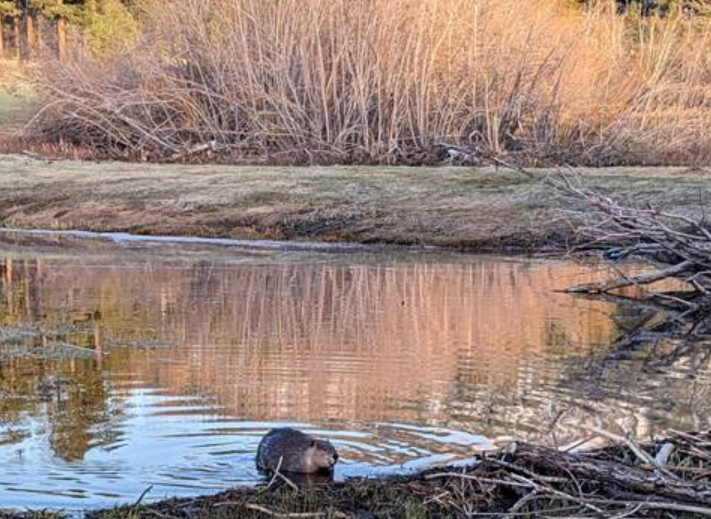It’s Saturday morning and since we can’t watch cartoons and eat cereal on the floor anymore, I thought you’d enjoy my second favorite story a great community interest beaver whodunit.
Who were the busy beaver dam demolishers?
 DOUGLAS COUNTY, Nev. – What began as a routine walk for one community member turned into a neighborhood effort to save a beaver.
DOUGLAS COUNTY, Nev. – What began as a routine walk for one community member turned into a neighborhood effort to save a beaver.
While on this walk, one community member found what they described as a destroyed beaver dam near the Tahoe Beach Club and bare dirt and tire tracks near an adjacent creek in post, which has since been deleted, on Nextdoor.com. The photo accompanying the post showed a tangle of branches divided by a path of water moving through it.
Just north of the Tahoe Beach Club, between U.S. Highway 50 and Nevada Beach, is a U.S. Forest Service owned parcel on which a slew of restoration projects are planned. Rabe Meadow, Burke Creek and Jennings Pond are on this site. Beaver activity is often spotted there. The community has dubbed one of these inhabitants, Beaver Burke, complete with his own Facebook fan page. Douglas County Lake Tahoe Sewer Authority also operates a pump station on this land with an access road from the Tahoe Beach Club.
Ohh a missing photo and nextdoor entry! I’ve been there. Do you know in the first early days of Martinez Beaver Bruhaha I noticed that someone was changing the Wikipedia entry on our beavers sometimes twice a day? They were either environmental heroes restoring the creek or maurading bandits destroying the city infrastructure. And usually both twice a day.
Within the post, the individual claims after a phone call to Nevada Wildlife, likely the Nevada Department of Wildlife, they learned the sewer authority asked if they could remove the dam and kill the beavers to stop flooding.
Prior to the post being deleted, it garnered many comments from concerned residents and was shared to a Facebook page called Beaver Burke Fan Club with over 650 friends. On this fan page, posts further allege the Douglas County Lake Tahoe Sewer Authority of requesting a depredation permit to kill Beaver Burke and his family. Some beaver fans posted notices of the sewer authority’s board meeting on March 20, rallying members to provide public comment.
The fan page and neighborhood app has gotten many talking and speculating about who was busy destroying the beaver dam and potentially wanting to kill the beavers.
It’s funny because facebook invited me to join the Burke Beaver fan club just yesterday. Obvious the crack algorithym has somehow discerned the subtle interest focus I have for beavers. Amazing technology.
Meghan Kelly with the Nevada Tahoe Conservation District, one of the restoration project partners tells the Tribune, “I do know that the Sewer District had reached out to the Nevada Division of Wildlife inquiring at least about pulling out the dams.”
The Nevada Department of Wildlife could not confirm whether they were contacted by the sewer authority to pull out the dams, but as of April 10, have received no depredation permit applications to remove beavers in that area.
The conservancy district also believes the beaver dams were destroyed by the sewer authority around March 8 to alleviate flooding of the pump station access road; although, the conservation district doesn’t believe this would solve the flood problem.
The Tribune has made multiple attempts to contact the sewer authority and received no response. There was one minor mention of beavers in their Board Meeting Minutes from Feb. 21 while discussing sewer pump access road relocation with the restoration project managers.
The minutes say, “After a brief discussion regarding beaver dams in the area and how they impact drainage and flooding…,” but the sentence then goes on to detail the Tahoe Beach Club’s concerns with the access road relocation, without elaborating on the beaver discussion.
Hmmmm…so beavers were discussed but there was no actual plan to deal with them. Or none WRITTEN DOWN. This is sounding more familiar every moment.
Both the conservation district and the forest service say in this case, they would not be supportive of removing the dams. Its possible the dams may be breached during their restoration work, but they’ve specifically timed that work outside of beaver kit rearing season after Aug. 15.
The forest service adds, watershed restoration, infrastructure or public safety threats occasionally require partial or complete removal of beaver dams, but that’s usually a temporary fix as beavers tend to build the dams back up quickly. Their preferred method of mitigation is to use beaver deceiver pipes or infrastructure upgrades to keep infrastructure from flooding, as is the case at Taylor Creek near the Stream Profile Chamber.
Kelly with the conservation district says the restoration project at Burke Creek and Rabe Meadow has set phasing and protection measures designed to limit disturbance to the beavers and hopes the beavers will continue to inhabit the site, “The Conservation District feels the beavers are integral to the success of the stream restoration project.”
The district has written a memo on the beavers, published in August. The memo identifies two beaver colonies in the project area. One is centered at Jennings Pond, and the other near where Burke Creek and the Kahle Ditch meet adjacent to the Tahoe Beach Club.
Well well well. The plot is getting plenty thick. I can’t tell you the number of times I have read about some eager public works brute ripping out a dam and then, when caught on camera, stammers with the mayor into saying how MUCH the city likes the beavers and wants them to stay.
According to NDOW, a depredation permit would allow the landowner or manager to hire someone to lethally remove beavers. Ashley Zeme with the department says, “People typically only reach out when there is an imminent risk of damage to infrastructure or landscaping,” adding, “The situation has already become a problem by the time they request a permit.”
NDOW encourages property owners to take measures to prevent beavers before they become an issue, saying the permit is a last resort.
Regarding whether beavers can be relocated as opposed to killed, NDOW says that is extremely difficult to do successfully. “There is only a small timeframe in the year– late fall– when relocating them is feasible, and even then” Zeme says, “it’s not always successful.”
Zeme explains beavers are smart and territorial. “If they are moved before the late fall, they will try to make their way back to where they came from. This typically ends up in them becoming prey to other animals as they search for their former home.”
On the flipside, if they try to relocate them too late in the year, they don’t have time to build a den and prepare for winter. Other factors that make relocation difficult are risk of disease transmission, limited available habitat not already occupied by other beavers, and potential to create infrastructure issues elsewhere.
Relocation ain’t the answer. Solving yer problem by installing a flow device is. Just to clarify: Ripping out the dam won’t get rid of your beavers. Your beavers do not live IN the dam. You knew that right?





































